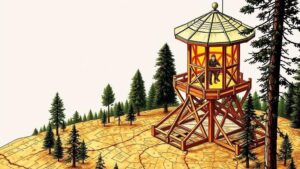Mining Prohibition-Era Smuggling Routes for Buried Cache Clues
Introduction
The period of mining prohibition in various jurisdictions, notably during the early-to-mid 20th century, was marked by significant underground economic activities. These activities included smuggling operations that capitalized on the valuable resources being extracted from the earth. This article examines the historical context of mining prohibition, explores the smuggling routes utilized during this era, and discusses the methodologies for uncovering buried caches of valuable materials.
Historical Context of Mining Prohibition
Beginning in the late 19th century and extending through the mid-20th century, numerous countries implemented mining prohibitions aimed at preserving natural resources and reducing environmental impacts. For example, the United States enacted the Taylor Grazing Act in 1934, which restricted mining activities on public lands combat soil degradation and overgrazing.
These prohibitions led to an underground economy fueled by illicit smuggling activities. The restrictions on legal mining operations inadvertently heightened the demand for unregulated extraction, resulting in the formation of a complex network of smuggling routes.
Notable Smuggling Regions and Routes
Several key regions emerged as hotspots for mining prohibition-era smuggling. These routes were often characterized by their clandestine nature and geographical advantages. following areas are notable:
- Appalachian Mountains: Stretching across the eastern United States, this area became notorious for coal smuggling, particularly during the coal-mining bans in the 1930s.
- The Sierra Nevada Range: Gold and silver smuggling operations thrived in California after strict mining controls were established in the early 20th century.
Strategies and Techniques for Smuggling
Smugglers employed various techniques to evade law enforcement and transport illicitly mined resources. Common strategies included:
- Use of Remote Locations: Smugglers often selected remote, difficult-to-access regions for caching resources, reducing the chance of interception.
- Disguised Transportation: Participants frequently disguised their transport vehicles or blended shipments with legal goods to obscure their illicit cargo.
Methodologies for Uncovering Buried Caches
The search for buried caches linked to smuggling operations requires a multidisciplinary approach that incorporates historical research, archeological techniques, and modern technology.
Historical and Cartographic Research
Examining historical records, including mining permits, smuggling reports, and old maps, is crucial. For example, the U.S. Geological Survey archives provide extensive information on historical mining claims and can guide researchers to probable smuggling routes.
Modern Technology Utilization
Recent advances in technology have greatly enhanced our ability to detect buried caches of valuable minerals. Techniques such as:
- Ground Penetrating Radar (GPR): This non-invasive method uses radar pulses to image the subsurface, revealing potential buried caches without extensive digging.
- Geographic Information Systems (GIS): GIS technologies can analyze spatial data and identify trends or patterns in historical smuggling routes, optimizing cache location searches.
Conclusion
The mining prohibition era served as a catalyst for a clandestine economy driven by smuggling. Understanding the historical context and smuggling routes of this period is essential for uncovering buried caches that may still remain undiscovered. By leveraging historical research and modern technological advances, researchers can better identify and explore these hidden treasures of the past.
Actionable Takeaways
To wrap up, effective research methodologies that combine historical analysis with modern technology can yield significant findings related to buried smuggling caches. Future explorations in areas with historical mining activity may uncover artifacts that illustrate the impact of prohibition on the mining industry and illicit trade.



